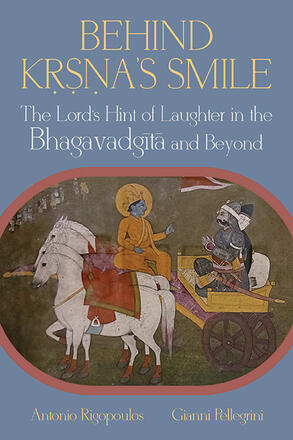
Behind Kṛṣṇa’s Smile
The Lord’s Hint of Laughter in the Bhagavadgītā and Beyond
Examines Kṛṣṇa’s hint of laughter (prahasann iva) in the Bhagavadgītā, its interpretations in the Vedānta commentarial tradition, and its significance in Kṛṣṇaite iconography and literature.
Description
Behind Kṛṣṇa's Smile offers a wholly original perspective on the celebrated Bhagavadgītā, or "Song of God." The book investigates Kṛṣṇa's hint of laughter (prahasann iva) in Bhagavadgītā 2.10, which is generally understood to be the turning point of the famous poem, signaling the outpouring of his grace and teaching to Arjuna. Remarkably, it is from this verse that Śaṅkara and other leading theologians begin to write their commentaries. In addition to exploring the momentousness of Kṛṣṇa's hint of laughter and its impact on the poem's central teachings, Behind Kṛṣṇa's Smile provides a crucial interpretation of Kṛṣṇa's prahasann iva in the Vedānta commentarial tradition, from Śaṅkara up to modern times. The book also considers the meanings of the stock phrase prahasann iva in the larger epic framework of the Mahābhārata and Rāmāyaṇa. Moreover, the book offers the first comprehensive review of the significance of Kṛṣṇa's smile in Kṛṣṇaite iconography and literature, demonstrating that there is a unified canon bringing together the literary and performative dimensions of Kṛṣṇa’s hint of laughter.
Antonio Rigopoulos is Professor of Sanskrit Language and Literature at the Ca’ Foscari University of Venice, Italy. His previous books include The Hagiographer and the Avatar: The Life and Works of Narayan Kasturi and Dattātreya: The Immortal Guru, Yogin, and Avatāra, both published by SUNY Press. Gianni Pellegrini is Associate Professor of Sanskrit Language and Literature and Indian Philosophy and Religions at the University of Turin, Italy.
Reviews
"This book tackles an element of the Bhagavadgītā, namely Kṛṣṇa's smile as he is just about to start his instruction of Arjuna right before the fratricidal war on Kurukṣetra. As the authors note, this is a most interesting detail in the text and its setting—the Mahābhārata—yet one that has been entirely overlooked by scholarship. The authors provide a convincing analysis of the significance of Kṛṣṇa's smile and its poignant function of marking a transition from silence to instruction, as well as a very useful contextualization in the wider currents of South Asian culture and literature." — Aleksandar Uskokov, Yale University